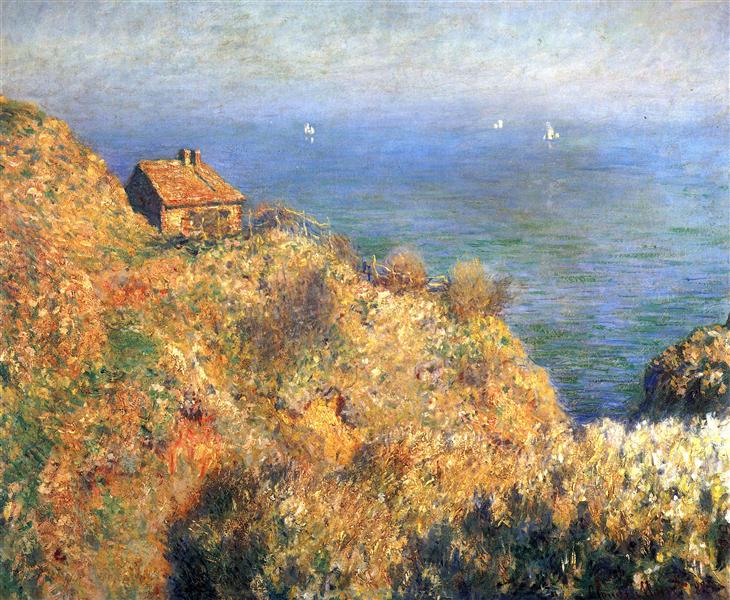Description
Claude Monet's "Fisherman's House at Varengeville", painted in 1882, is a sublime representation of the artist's mastery in the use of color and light, characteristics that have defined his career and the Impressionist movement in general. Monet, a key figure within Impressionism, found in this small town on the Normandy coast a perfect setting to capture the essence of the landscape and the daily life by the sea.
The painting features a composition that focuses on a fisherman's house, which stands on high ground, against a backdrop of greens and yellows that blend into a bright and vibrant atmosphere. The structure, in warm tones that contrast with the freshness of the surroundings, evokes a sense of harmony and belonging that is deeply evocative. Monet uses loose, gestural brushstrokes, emblematic of his style, to suggest the texture of the vegetation and the construction of the house, creating an atmosphere that seems to be alive and in constant movement.
The use of colour is undoubtedly one of the most fascinating aspects of this work. Monet reveals his ability to capture light at different times of the day, reflecting his constant exploration of the interaction between light and the natural landscape. Yellow and green tones predominate, imbuing the work with an air of warmth that invites the viewer to immerse themselves. The chromatic coherence between the house and the surroundings, together with the soft blue sky, create an atmosphere of serenity and tranquility that invites contemplation.
As for the representation of human beings, the work lacks prominent figures, which gives a more intimate and personal reading to the landscape. The absence of characters suggests a contemplative world where nature and the everyday environment are the protagonists. This choice by Monet can be interpreted as a commentary on the relationship between man and his environment, a recurring theme in his work, where nature often takes centre stage.
"Fisherman's House at Varengeville" is a clear example of Monet's desire to capture perceptual experience. In the 1980s, Monet was deeply interested in exploring the influence of weather and light on the landscape; an area where his work truly flourished. In this work, the capture of the ephemeral moment and the constant change in nature are manifested in Monet's free and descriptive brushwork, emphasizing the passage of time through light.
The painting is not only a testament to his technique and sensitivity, but also a reflection of the transformations of the French scene in the 19th century, a time when modernity was beginning to make its appearance. The humble and rustic fishermen's houses become symbols of an enduring connection between man and the sea, a theme that Monet had begun to explore in earlier works.
Without a doubt, “Fisherman’s House at Varengeville” falls within a significant period of Monet’s life, where his artistic practice was totally in tune with his surroundings. The work not only captures a place, but also offers a window into the vision of one of the greatest masters of Impressionism, whose relentless search for light and colour continues to resonate. Through this painting, Monet not only presents a landscape, but also invites us to contemplate the sublime and transitory beauty of nature.
KUADROS ©, a famous painting on your wall.
Hand-made oil painting reproductions, with the quality of professional artists and the distinctive seal of KUADROS ©.
Painting reproduction service with satisfaction guarantee. If you are not completely satisfied with the replica of your painting, we will refund 100% of your money.

